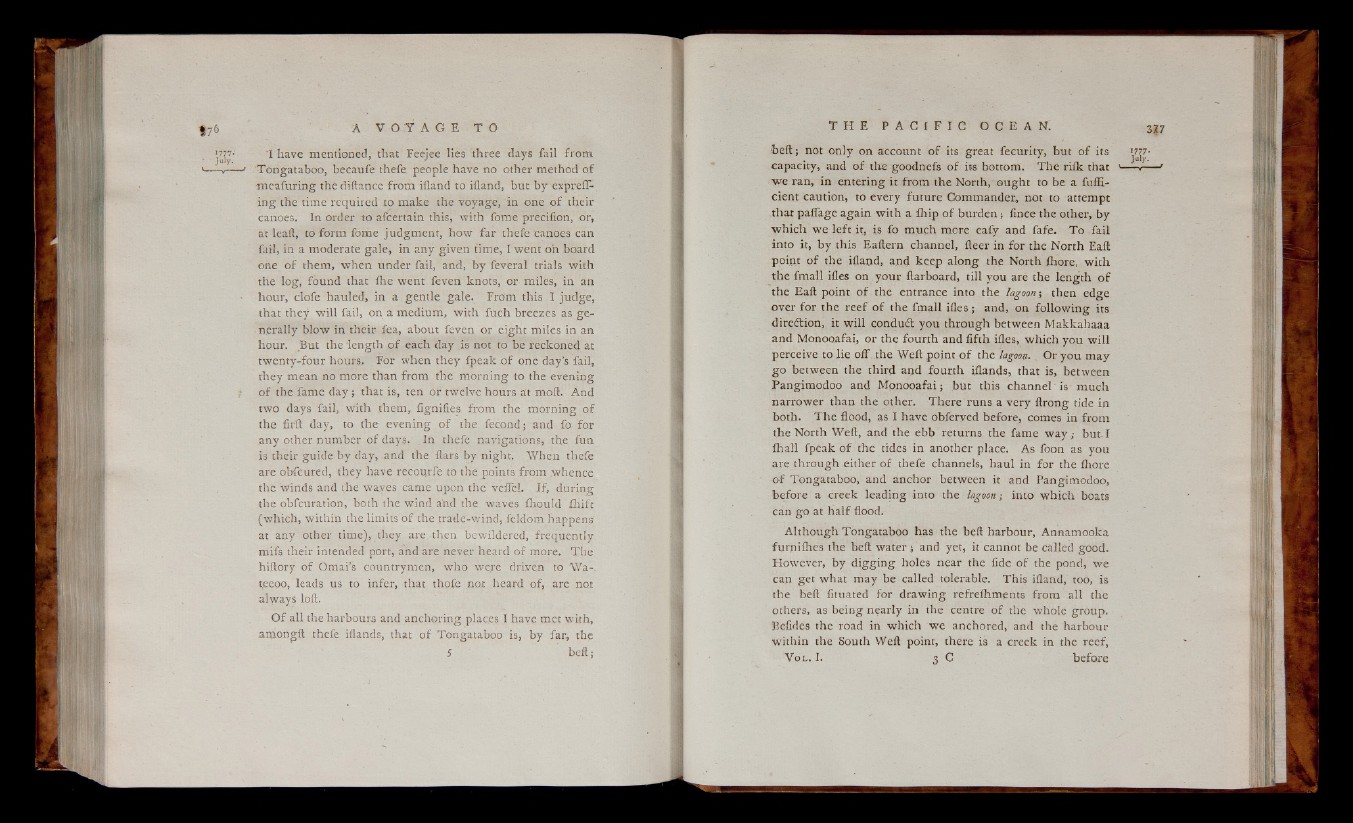
juiJ' 'I have mentioned, that Feejee lies three days fail from
<— v 1 Tongataboo, becaufe thefe people have no other method of
meafuring thediftance from ifland to ifland, but by expreff-
ing the time required to make the voyage, in one of their
canoes. In order to afcertain this, with fome precifion, or,
at leaft, to form fome judgment, how far thefe canoes can
fail, in a moderate gale, in any given time, I went oh board
one of them, when under fail, and, by feveral trials with
the log, found that ihe went feven knots, or miles, in an
hour, clofe hauled, in a gentle gale. From this I judge,
that they will fail, on a medium, with fuch breezes as generally
blow in their fea, about feven or eight miles in an
hour. But the length of each day is not to be reckoned at
twenty-four hours. For when they fpeak of one day’s fail,
they mean no more than from the morning to the evening
of the fame day; that is, ten of twelve hours at moll. And
two days fail, with them, lignifies from the morning of
the firft day, to the evening of the fecond; and fo for
any other number of days. In thefe navigations, the fun
is their guide by day, and the liars by night. When thefe
are obfcured, they have recourfe to the points .from whence
the Winds and the wayes came upon the’ veflel. If, during
the obfcuration, both the wind and the waves fhould Ihift
(which, within the limits'of the trade-wind, feldom happens;
at any other time), they are then bewildered, frequently
mifs their intended port, and are never heard of more. The
hillory of Omai’s countrymen, who were driven to Wa-.
tjeeoo, leads us to infer, that thole not heard of, are not
always loft.
Of all the harbours and anchoring plac.es I have met with,
amongft thefe iflands, that of Tongataboo is, by far, the
heft; not only on account of its great fecurity, but of its '777-
capacity, and of the goodnefs of its bottom. The rilk that v t
we ran, in entering it from the North, ought to be a fuffi-
cient caution, to every future Commander, not to attempt
that paifage again with a ill ip of burden; fince the other, by
which we left it, is fo much more eafy and fafe. To fail
into it, by this Eaftern channel, fleer in for the North Eaft
poip.t of the ifland, anfl keep along the North fliore, with
the fmall ifles on your flarboard, till you are the length of
the Eaft point of the entrance into the lagoonthen edge
over for the reef of the fmall ifles; and, on following its
direition, it will conduit you through between Makkahaaa
and Monooafai, or the fourth and fifth ifles, which you will
perceive to lie off the Weft point of the lagoon.. Or you may
go between the third and fourth iflands, that is, between
Pangimodoo and Monooafai ; but this channel is-much
narrower than the other. There runs a very ftrong tide in
both. The flood, as I have obferved before, comes in from
the North Weft, and the ebb returns the fame way; but I
Ihall fpeak of the tides in another place. As foon as you
are through either of thefe channels, haul in for the fliore
of Tongataboo, and anchor between it and Pangimodoo,
before a creek leading into the lagoon; into which boats
can go at half flood.
Although Tongataboo has the beft harbour, Annamooka
furnifheS the beft water ; and yet, it cannot be called good.
However, by digging holes near the fide of the pond, we
can get what may be called tolerable. This ifland, too, is
the beft fituated for drawing refreihments from all the
others, as being nearly in the centre of the whole group.
Befides the road in which we anchored, and the harbour
within the South Weft point, there is a creek in the reef,
V o l . I. 3 C before